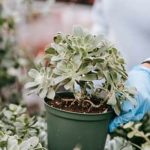Are you considering starting a vegetable garden but don’t have a lot of space or access to a traditional garden plot? Container vegetable gardening might be the perfect solution for you. In this article, we will explore the benefits of container gardening and provide guidelines for selecting the right containers for your vegetables.
Container vegetable gardening offers numerous advantages, especially for those with limited outdoor space. Whether you have a small patio, balcony, or even just a sunny windowsill, you can still grow a variety of vegetables in containers. This allows urban dwellers and those with minimal outdoor space to enjoy the satisfaction of growing their own food. Additionally, container gardening can be more accessible for individuals with physical limitations as it requires less bending and stooping than traditional gardening.
When it comes to container gardening, one of the most important factors to consider is the size of the containers. The size of your containers will impact the growth and development of your vegetables, so it’s crucial to select appropriately sized containers for each type of plant.
In the following sections, we will discuss how to choose the right containers based on factors such as material and drainage, as well as ideal sizes for different types of vegetables like tomatoes, peppers, and lettuce. So if you’re wondering “what size containers for vegetable gardening,” keep reading for expert advice on getting started with your own container garden.
Selecting the Right Container
When it comes to selecting the right containers for your vegetable garden, there are several factors to consider. The size, material, and drainage of the container all play a crucial role in the success of your garden. By understanding these factors, you can set your vegetable garden up for optimal growth and productivity.
Size
The size of the container is one of the most important considerations for successful vegetable gardening. Larger vegetables like tomatoes and peppers require deeper and wider containers to accommodate their root systems. On the other hand, smaller vegetables like lettuce or herbs can thrive in smaller containers. It’s essential to research the specific space requirements of each vegetable you plan to grow and select a container size that will allow for adequate root development.
Material
The material of the container also plays a significant role in the health of your vegetable plants. Common materials for containers include plastic, ceramic, terracotta, or fabric. Each material has its advantages and disadvantages when it comes to insulation, drainage, and water retention.
For example, plastic pots are lightweight and retain moisture well, while terracotta pots are porous and offer better airflow to plant roots. Consider the climate in your area and the watering needs of your vegetables when selecting a container material.
Drainage
Proper drainage is essential for container gardening success. Without adequate drainage holes at the bottom of your containers, excess water can accumulate and lead to root rot or other diseases in your plants. When selecting containers for vegetable gardening, ensure that they have sufficient drainage holes or consider drilling additional holes if necessary. Additionally, using a layer of rocks or gravel at the bottom of the container can help improve drainage and prevent waterlogged soil.
By carefully considering factors such as size, material, and drainage when selecting containers for your vegetable garden, you can create an optimal environment for your plants to thrive. Properly chosen containers contribute to healthy root development and overall plant growth, ultimately leading to a bountiful harvest of homegrown vegetables.
Ideal Sizes for Different Vegetables
When it comes to container gardening, selecting the right size container is crucial for the successful growth of your vegetables. Different vegetables have different root systems and space requirements, so it’s important to choose the ideal container size for each type of vegetable.
Tomatoes
Tomatoes are one of the most popular vegetables to grow in containers. For determinate varieties (which grow to a certain height), a 5-gallon container is generally sufficient. However, for indeterminate varieties (which continue to grow and produce fruit throughout the season), a larger 10-gallon container is recommended to accommodate their extensive root system.
Peppers
Pepper plants can thrive in smaller containers compared to tomatoes. A 2-3 gallon container is suitable for bell peppers and other sweet pepper varieties, while hot pepper plants like jalapenos or habaneros can thrive in even smaller 1-2 gallon containers.
Lettuce
Lettuce has more shallow roots compared to tomatoes and peppers, so they can be grown in smaller containers. A 6-8 inch deep planter box or pot with a minimum capacity of 4 gallons is ideal for growing lettuce. Keep in mind that lettuce also benefits from being planted in wider containers that allow for more surface area for planting multiple heads.
By understanding the specific container sizes recommended for different vegetables, you can ensure that your container garden will provide the necessary space for healthy growth and bountiful harvests.
Understanding Container Depth
The depth of a container plays a crucial role in the growth and development of certain vegetables and herbs in a container garden. Root vegetables like carrots, radishes, and potatoes require deeper containers to allow for proper root expansion. In general, the deeper the container, the larger the root system can grow, which is essential for these types of plants.
For root vegetables like carrots and potatoes, it is recommended to use containers that are at least 12 inches deep. This depth allows enough space for the roots to grow downwards without hitting the bottom of the container, which can cause stunted or deformed growth. For herbs such as rosemary, thyme, and lavender, a minimum depth of 8 inches is sufficient to accommodate their root systems.
It’s important to select containers with adequate depth based on the specific needs of the plants you plan to grow. Insufficient depth can result in poor growth and yield, while excessive depth can lead to wasted soil and unnecessary weight in larger containers.
| Vegetable/Herb | Ideal Container Depth |
|---|---|
| Carrots | 12 inches |
| Potatoes | 12 inches |
| Rosemary | 8 inches |
| Thyme | 8 inches |
When growing a variety of plants in a single container or implementing vertical gardening techniques, consider using tiered planters or stacking pots to provide different depths for various types of vegetables and herbs. Understanding how container depth impacts plant growth is essential for successful container vegetable gardening.
Creative Container Options
When it comes to container gardening, there are plenty of creative options beyond the traditional pot. Thinking outside the box can lead to unique and innovative ways to grow your vegetables. One alternative container option is using buckets, which are an affordable and easy way to repurpose an item that would otherwise be discarded.
They provide plenty of room for root growth and are easily moveable if needed. Crates are another unconventional choice that can add a rustic or vintage aesthetic to your garden. They can be stacked for vertical gardening or used individually for a more spread-out look.
Raised beds are yet another creative option for container gardening. They provide excellent drainage and allow for deep root growth, making them ideal for growing a variety of vegetables.
Additionally, raised beds can be particularly beneficial for those with back problems as they reduce the need for bending or kneeling while tending to the garden. Whatever alternative container you choose, it’s important to ensure that it has proper drainage holes and is large enough to accommodate the specific vegetable you plan on growing.
In addition to buckets, crates, and raised beds, there are countless other options for creative container gardening. Consider repurposing items such as wheelbarrows, pallets, or even old furniture into unique and eye-catching planters. When selecting alternative containers, it’s essential to consider size, material durability, and drainage capabilities in addition to their visual appeal. By thinking creatively about your container choices, you can make your vegetable garden not only bountiful but also visually interesting and unique.
| Container Option | Advantages |
|---|---|
| Buckets | Affordable, easy to move |
| Crates | Rustic aesthetic, great for vertical gardening |
| Raised Beds | Excellent drainage, deep root growth |
Maintaining Container Gardens
Container gardening offers many benefits, including the ability to control soil conditions, water usage, and pest management more easily than traditional garden beds. However, to ensure the success of your container vegetable garden, it’s crucial to maintain proper watering, fertilizing, and pest control. Here are some essential tips for maintaining a healthy container garden:
- Proper Watering: The key to successful container gardening is providing adequate water without overwatering. When it comes to watering your container vegetables, it’s important to check the soil moisture regularly and adjust your watering schedule based on the specific needs of each plant. Consider using a moisture meter to determine when to water your containers, as different plants have varying water requirements.
- Fertilizing: Since container plants are confined to a limited amount of soil, it’s essential to provide them with regular nourishment through fertilization. Choose a high-quality fertilizer designed for vegetables and follow the label instructions for application frequency and dosage. Avoid overfertilizing your plants, as this can lead to nutrient imbalances and potentially harm the vegetables.
- Pest Control: Container gardens are not immune to pests, so it’s crucial to monitor your plants regularly for signs of infestation. Use organic pest control methods whenever possible to avoid introducing harmful chemicals into your vegetable garden.
Additionally, companion planting can help deter pests by creating a more balanced ecosystem in your containers. Keep an eye out for common pests such as aphids, caterpillars, and spider mites and take prompt action to prevent damage to your vegetable plants.
Space-Saving Techniques
When space is limited, it’s important to maximize the area you do have in order to grow a successful container vegetable garden. Here are some strategies for space-saving and vertical gardening:
- Vertical Gardening: Utilize trellises or stakes to grow climbing vegetables like tomatoes, cucumbers, and peas vertically. This not only saves space but also helps prevent diseases by keeping the plants off the ground.
- Hanging Baskets: Consider hanging baskets for growing herbs, strawberries, or small varieties of tomatoes to free up ground space.
- Stackable Planters: Use stackable planters or tiered containers to create a vertical garden, allowing you to grow multiple plants in a smaller footprint.
Vertical gardening not only maximizes limited space, but it can also make tending to your plants easier by bringing them closer to eye level. Additionally, it adds visual interest and beauty to your garden by creating height and dimension.
Another technique for saving space in container gardening is using compact or dwarf varieties of vegetables. These plants are specifically bred to be smaller in size while still producing full-sized fruits or vegetables. By choosing compact varieties of tomatoes, peppers, and other vegetables, you can grow more plants in less space.
Lastly, consider planting crops that can be grown close together without competing for resources. For instance, interplanting lettuce with radishes allows you to utilize the same container for two different crops without sacrificing yield. By carefully planning out your container garden layout and utilizing vertical space, you can make the most of limited gardening space while still enjoying a bountiful harvest.
Troubleshooting Common Issues
In conclusion, container vegetable gardening can be a rewarding and productive way to grow your own produce, even in limited space. By selecting the right container size, material, and ensuring proper drainage, you can create an ideal environment for your vegetables to thrive. Understanding the ideal sizes for different vegetables and the depth requirements for root vegetables and herbs will help you make the most of your container garden.
It’s important to think creatively when it comes to containers, considering options like buckets, crates, or raised beds to suit your space and aesthetic preferences. Additionally, maintaining your container garden with proper watering, fertilizing, and pest control is crucial for healthy plant growth. Space-saving techniques such as vertical gardening can also help you maximize your available space and increase your vegetable yield.
When troubleshooting common issues in container gardening, it’s essential to address problems like overcrowding, root-bound plants, and container size limitations. By proactively monitoring the growth of your plants and making adjustments as needed, you can avoid these issues and ensure the success of your container vegetable garden. With careful planning and attention to detail, anyone can enjoy a bountiful harvest from their own container garden.
Frequently Asked Questions
What Size Pots Do I Need to Grow Vegetables?
The size of pots needed to grow vegetables depends on the specific type of vegetable you want to grow. Generally, larger pots are needed for larger plants like tomatoes or peppers, while smaller pots can work for herbs and small vegetables.
It’s important to consider the depth and width of the pot to accommodate the roots and provide enough space for growth.
How Many Vegetables Can I Grow in a 5 Gallon Container?
In a 5 gallon container, you can typically grow one large vegetable plant such as a tomato or pepper. For smaller vegetables like lettuce, radishes, or herbs, you may be able to grow multiple plants in the same container. It’s essential to consider the mature size of each plant and ensure they have enough space to thrive.
What Is the Best Container for a Vegetable Garden?
The best container for a vegetable garden is one that provides adequate drainage, is large enough for the mature size of the plants, and is made of a durable material like plastic, ceramic, or wood. Fabric pots are also a popular choice as they provide good air circulation to the roots.
Ultimately, the best container will depend on the specific needs of the vegetables you plan to grow and your individual gardening preferences.

If you’re looking to get into vegetable gardening, or are just looking for some tips on how to make your current garden better, then you’ve come to the right place! My name is Ethel and I have been gardening for years. In this blog, I’m going to share with you some of my best tips on how to create a successful vegetable garden.





